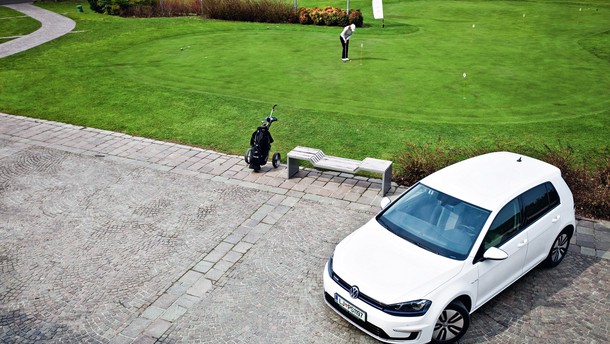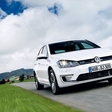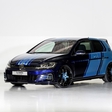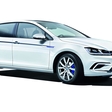
Although the phrase "Golfing with a Golf" has been slightly overused, we took a step further and drove the electric Volkswagen Golf to an eco-friendly golf course near Padua in Italy. Our point of departure was the airport in Venice, since it connects many capitals and interesting coastal cities around the world. The airport has a diverse range of cars for rental, and they must also have some electric ones. Perhaps the e-Golf, since we're headed to a golf course?
The distance between Venice and Verona is about 120 kilometers, and it's well worth heading there for a romantic dinner, to enjoy a cultural event in the Roman amphitheater or visit Romeo's Juliet (her right breast is also quite worn out, which means that, according to the legend, many couples are now happily in love, as the legend says that rubbing it's breast means happy relationship). This route should be a piece of cake for the Golf, with its 85 kW electric motor and 318kg battery, which is located between the front and rear axle, with a 24.2 kWh capacity, since its range theoretically reaches 190 kilometers. But considering the fact that you always need to keep something in reserve, and that it's not recommended to drive at only 80 km/h on Italian highways, and that the automatic air conditioning, radio and navigation consume a lot of energy, the actual range is just about perfect for us to drive from the airport to the hotel in the center of Verona. Courage with speed and consumption does not apply here, therefore it's best to choose the ECO mode at the beginning of your drive, which allows a maximum speed of 115 km/h. This is fast enough for a comfortable drive, without the need to camp out in the right lane, nestled among the trucks.

Volkswagen's e-Golf is a full-electric car, not a hybrid, as most random observers thought. This can be ascribed to a popular TV ad for a more high-performance version, the GTE. Ours was only e, so the e-Golf. You can choose one of the three programs on the selective menu, on the intuitive touch-screen: Normal, Eco and Eco+. The first enables you to speed up to 140 km/h; however, this proportionally decreases the drive range. In Eco mode, motor power is reduced to 70 kilowatts, and peak torque to 220 Nm, and the responsiveness of the accelerator and the air conditioning also change. The most energy-saving option is, of course, Eco+. In this mode, the motor's performance reaches 55 kilowatts and has 175Nm peak torque, and the maximum speed is reduced by 25 kilometers per hour, in comparison with the Eco mode, thus from 115 to 90 km/h. The air conditioning does not function in this mode (and we didn't miss it on our early spring tour across northern Italy), and the accelerator is even less responsive. When you press the accelerator to its maximum (the so-called "kickdown") and try to overtake other vehicles, the system engages full power, since this is a safety issue, dnd Volkswagen take safety really seriously. The electric version of the Golf behaves like a completely ordinary car which, despite the additional weight of the batteries, and it copes excellently with bumpy roads and guarantees superb noise insulation. I don't know if you've ever noticed, but winter tires (our e-Golf had completely ordinary Nokian winter tires, with dimensions 205/55 R16) are actually quite loud. Noise from the tires in a car with a classic internal combustion engine never drowns out the engine noise, but in the e-Golf, this noise began to bother me quite quickly. Yes, you quickly get spoiled by the good things...

The e-Golf also spoils you with its equipment, since it has it all, from the rearview camera to navigation—even the trunk is only 39 liters smaller than its fuel-driven brother. This feels like a completely normal car, and not a stripped shell, like the first electric cars, which made you ashamed of the "sheet metal" sound, when handling its doors. What do you need to know before taking it for a drive? Only the fact that, after starting it, instead of hearing a loud motor sound, the sign Ready appears on the display. Everything else is just the same as driving a classic Golf with automatic transmission. Well, we have to add that the gearshift lever is used to choose programs D1, D2, D3 and B, which define the recuperation level. Competitive cars very quickly come to a stop when you release the throttle, but the Golf is quite similar to classic cars in this aspect.
Before visiting the famous Juliet, we turned into the suburbs of Padua, to visit the golf course. This is not an ordinary golf course, since it has won the Golf Environment Organization (GEO) certificate and Committed to Green certificate, awarded by the Italian National Golf Association (Federazione Italiana Golf). The Golf della Montecchia resort came into being in 1988, when numerous entrepreneurs from Padua merged to do something together. They hired Tom Macaulay to set up the golf course. He subsequently became the President of the British Golf Course Architects Association. According to the statistics, the golf course has 27 holes and three teeing grounds – white, red and yellow.

The course's eco-related story, confirmed by both certificates, is more interesting than the shape of the course itself. Think about what this means: a lot less water for watering the grass, a lot less energy for the accompanying facilities, green suppliers, and fewer chemicals to make the grass look like many of us would want to have it at home. Since we visited the course before the main season, the grass still had not recuperated from the low winter temperatures. The major change on the course was the laying of a special grass called Bermuda grass. In principle, it has nothing to do with the Bermuda Islands, since the grass itself originates elsewhere (South America, the Middle East). However, due to its durability and great image, it is more than appropriate for a golf course.

The quantity of water used to keep it green has been lowered by 70% at Golf della Montecchia, since the course is watered only once a week, whereas before it was watered three times a week. Even though the grass did not show itself in all its glory during our visit, it is also appropriate for the temperatures which are common in the Padania region, from -10 to +36 degrees Celsius. A lot of attention was also dedicated to the consumption of electricity, since it was lowered from 130 thousand kilowatts to only 40 thousand kilowatts. By setting up completely new water pumps, an ongoing process because the old pumps consumed the most energy, electricity consumption will be reduced by additional 25 percent. Well, the electric buggies, used by golf players to drive around the course, do not disturb the animals that live on the ten-hectare wild area, as the employees call the area within the course, with its numerous trees and bushes populated by ducks, rabbits, squirrels, turtles, frogs, pheasants, foxes, badgers, hedgehogs, herons, owls and other animals, which co-exist with the flying golf balls with no apparent problems. Forceful swings also brought out our hunger, which can be soothed by the Michelin-starred chef, Erminio Alajmo, in the very pleasant atmosphere of his prestigious restaurant. And if you still have any energy after a good meal, you can even refresh yourself in the saunas, a fitness center and an outdoor pool. We otherwise do not see any reason why a golf course would have a pool (the closest accommodation is available in a spa that is seven minutes away), but on the other hand: why give up luxury?
The annual membership fee is 2500 euros, which is clearly quite a low price for the 500 regular clients. We don't know whether the former owner of this estate observed us from the castle in the middle of the course, while we were driving the e-Golf around, but we can say that we did not stand out much among the masses of electric buggies used by golf players to get from one hole to the next.

We were also quite unobtrusive in the center of Verona. If all the cars around the arena were as quiet as the e-Golf, more couples would probably whisper their love declarations in the numerous restaurants surrounding the amphitheater.And the torque that the electric motor makes from standstill makes the Italian driving style around town (and you know how chaotic it can be) fun, and not such a stressful experience. Quiet, clean and efficient. And when you drive in the morning to one of the idyllic villages in the area, and have a real Italian coffee in a local bar, your "grazie per tutto"* comes directly from the heart.



